Serving 799 students in grades 9-12, Carmel High School ranks in the top 10% of all schools in California for overall test scores (math proficiency is top 20%, and reading proficiency is top 20%).
The percentage of students achieving proficiency in math is 56% (which is higher than the California state average of 33%). The percentage of students achieving proficiency in reading/language arts is 82% (which is higher than the California state average of 47%).
The student:teacher ratio of 15:1 is lower than the California state level of 21:1.
Minority enrollment is 38% of the student body (majority Hispanic), which is lower than the California state average of 80% (majority Hispanic).
Quick Stats (2025)
- Grades: 9-12
- Enrollment: 799 students
- Student:Teacher Ratio: 15:1
- Minority Enrollment: 38%
- Graduation Rate: ≥95% (Top 20% in CA)
- Overall Testing Rank: Top 10%
- Math Proficiency: 56% (Top 20%)
- Reading Proficiency: 82% (Top 5%)
- Science Proficiency: 40-44% (Top 30%)
- Source: National Center for Education Statistics (NCES), CA Dept. of Education
Top Rankings
Carmel High School ranks among the top 20% of public schools in California for:
Category
Attribute
Overall Rank
Math Proficiency
Reading/Language Arts Proficiency
Graduation Rate
Student Attention
School Overview
Carmel High School's student population of 799 students has declined by 5% over five school years.
The teacher population of 52 teachers has stayed relatively flat over five school years.
Grades Offered
Grades 9-12
Total Students
799 students
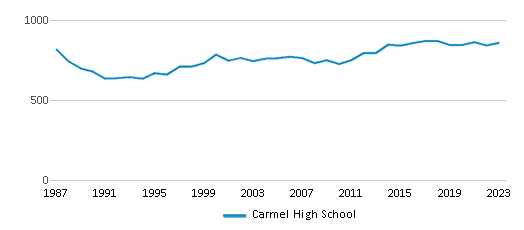
Gender %
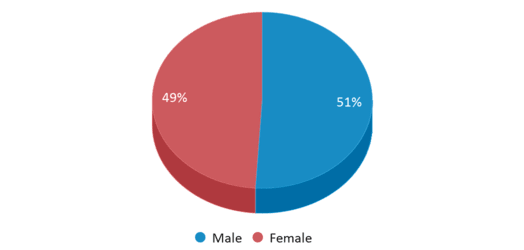
Total Classroom Teachers
52 teachers
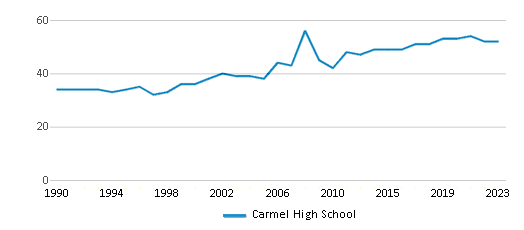
Students by Grade
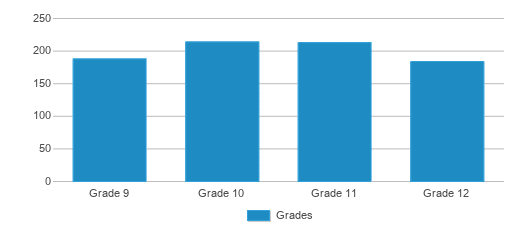
School Calendar
School Rankings
Carmel High School ranks within the top 10% of all 9,602 schools in California (based off of combined math and reading proficiency testing data).
The diversity score of Carmel High School is 0.56, which is less than the diversity score at state average of 0.63. The school's diversity has stayed relatively flat over five school years.
Overall Testing Rank
#859 out of 9602 schools
(Top 10%)
(Top 10%)
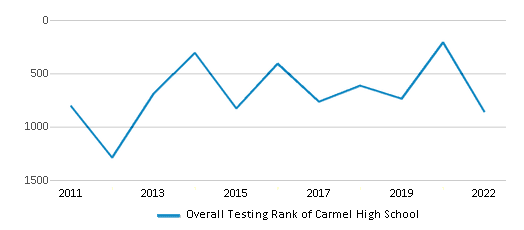
Math Test Scores (% Proficient)
56%
33%
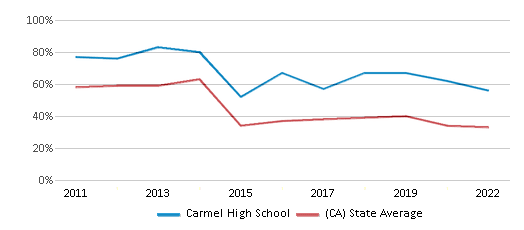
Reading/Language Arts Test Scores (% Proficient)
82%
47%
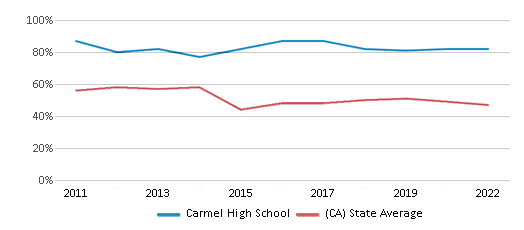
Science Test Scores (% Proficient)
40-44%
29%
Student : Teacher Ratio
15:1
21:1

American Indian
n/a
1%
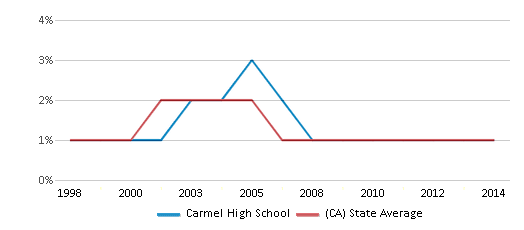
Asian
4%
12%
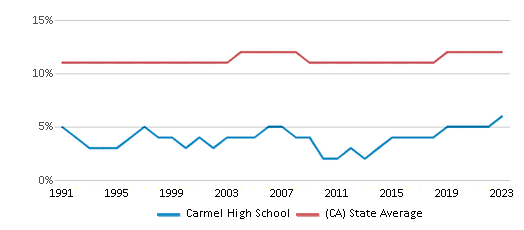
Hispanic
22%
56%
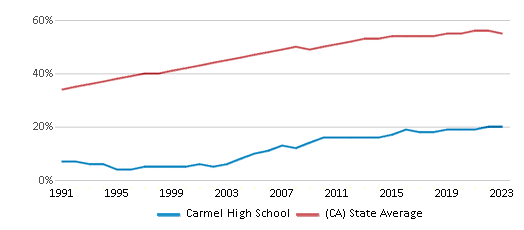
Black
1%
5%

White
62%
20%
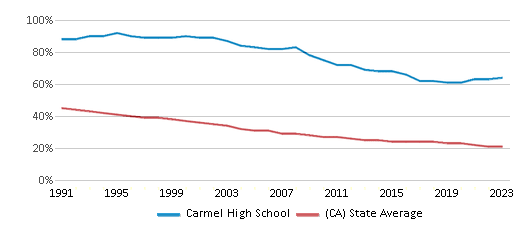
Hawaiian
n/a
n/a
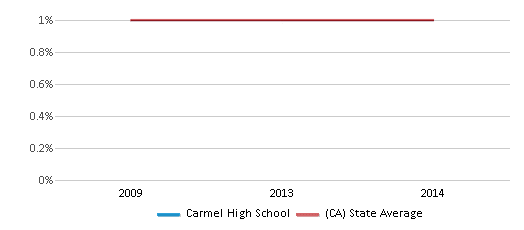
Two or more races
11%
6%
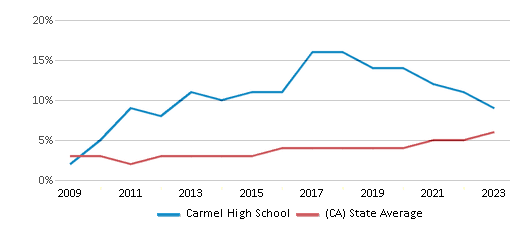
All Ethnic Groups
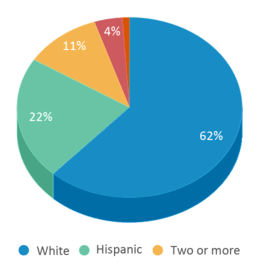
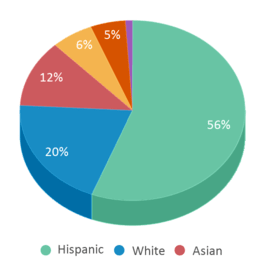
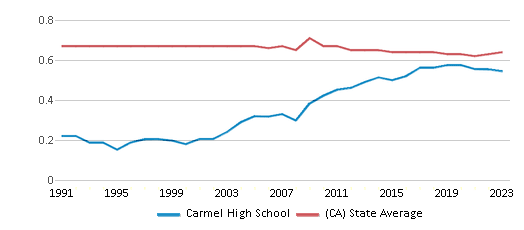
Graduation Rate
≥95%
87%
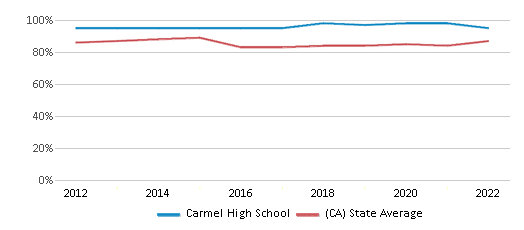
Eligible for Free Lunch
14%
54%
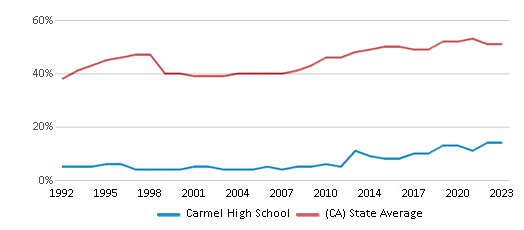
Eligible for Reduced Lunch
1%
8%
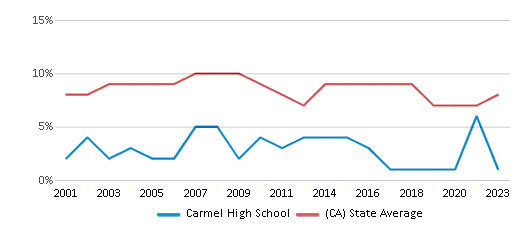
School Statewide Testing
School District Name
Source: National Center for Education Statistics (NCES), CA Dept. of Education
Profile last updated: 02/09/2025
Frequently Asked Questions
What is Carmel High School's ranking?
Carmel High School is ranked #859 out of 9,602 schools, which ranks it among the top 10% of public schools in California.
What schools are Carmel High School often compared to?
Carmel High Schoolis often viewed alongside schools like Pacific Grove High School, Monterey High School by visitors of our site.
What percent of students have achieved state testing proficiency in math and reading?
56% of students have achieved math proficiency (compared to the 33% CA state average), while 82% of students have achieved reading proficiency (compared to the 47% CA state average).
What is the graduation rate of Carmel High School?
The graduation rate of Carmel High School is 95%, which is higher than the California state average of 87%.
How many students attend Carmel High School?
799 students attend Carmel High School.
What is the racial composition of the student body?
62% of Carmel High School students are White, 22% of students are Hispanic, 11% of students are Two or more races, 4% of students are Asian, and 1% of students are Black.
What is the student:teacher ratio of Carmel High School?
Carmel High School has a student ration of 15:1, which is lower than the California state average of 21:1.
What grades does Carmel High School offer ?
Carmel High School offers enrollment in grades 9-12
What school district is Carmel High School part of?
Carmel High School is part of Carmel Unified School District.
School Reviews
3 7/20/2020
AVOID AP Chemistry and AP Environment teacher AT ALL COST. Stay away from it. This teacher shows the same attitude as students have, the fact that neither of them want to be there. He shows no enthusiasm or effort in teaching students. He is so confusing that I had to go to my private Chemistry teacher for help. This dude doesn't go over any of the material and leaves your stranded to complete assignments without knowing anything. Simply horrible!
5 9/6/2013
I am a grandmother to Rachel Goren. I saw in the newspaper a 35 minute film titled "from one second to the next" it is about the dangers of texting.
The filmmaker is Walter Herzog. Might be valuable in showing to students.
Review Carmel High School. Reviews should be a few sentences in length. Please include any comments on:
- Quality of academic programs, teachers, and facilities
- Availability of music, art, sports and other extracurricular activities
Recent Articles

What Is A Charter School?
Explore the world of charter schools in this comprehensive guide. Learn about their history, how they operate, and the pros and cons of this educational innovation. Discover key facts about charter schools, including admission policies, demographics, and funding, as well as what to look for when considering a charter school for your child.

10 Reasons Why High School Sports Benefit Students
Discover the 10 compelling reasons why high school sports are beneficial for students. This comprehensive article explores how athletics enhance academic performance, foster personal growth, and develop crucial life skills. From improved fitness and time management to leadership development and community representation, learn why participating in high school sports can be a game-changer for students' overall success and well-being.

February 05, 2025
Understanding the U.S. Department of Education: Structure, Impact, and EvolutionWe explore how the Department of Education shapes American education, from its cabinet-level leadership to its impact on millions of students, written for general audiences seeking clarity on this vital institution.





